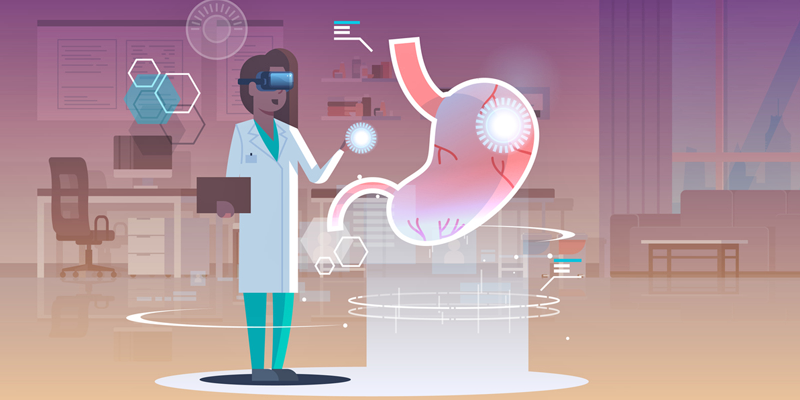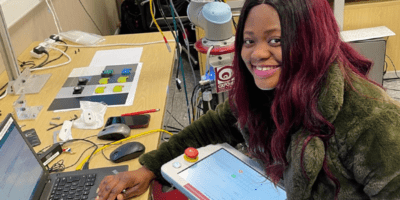Haley Mayer is a PhD student in mechanical engineering at the Hospital for Sick Children in Toronto. Haley began a master’s degree in mechanical engineering and part way through this she was able to take an exam that enabled her to transfer to a PhD. Her research as a PhD candidate now focuses on magnetically actuated surgical tools for gastroendoscopy, a test to check the inside of the throat, food pipe (oesophagus) and stomach, the upper part of the digestive system.
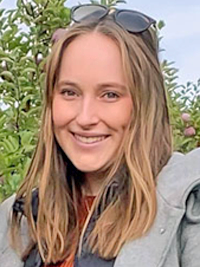
“Diversity is important in robotics because it touches everyone and everything.”
Combining medicine, mechanical design and biomechanics
I got my Bachelor of Engineering in Biomedical Engineering from the University of Guelph, in Canada, where I focused on the intersection between medicine, mechanical design, and biomechanics.
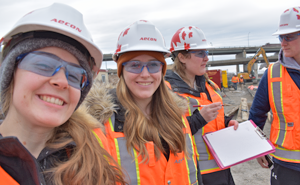
During the summers between the school year, I worked for Aecon Construction in the health and safety department, initially conducting safety inspections and updating the safety manuals. Later, I was able to apply my knowledge in biomechanics and occupational ergonomics, allowing me to conduct ergonomic assessments of construction sites preventing injury and improving worker health and safety.
After graduating in 2019 I realised I needed to go to graduate school to reach my career goals. I took a year off working at a ski and snowboard shop while interviewing at different universities and labs trying to find one that aligned with my research goals.
In September 2020, I started my master’s degree in mechanical engineering at the University of Toronto, where I am co-supervised between two labs: The Wilfred and Joyce Posluns Center for Image-Guided Innovation and Technological Intervention (PCIGITI) at the Hospital for Sick Children and the Microrobotics Lab at the University of Toronto.
During my master’s my research focused on magnetically actuated surgical tools and robots. At the University of Toronto, I am also the head teaching assistant for an occupational and industrial ergonomics engineering course.
Halfway through my master’s my supervisors suggested that my research project had a lot of space to grow and that I should apply to transfer my master’s into a PhD. After successfully completing my transfer from the master’s programme I began to prepare for my qualifying exam that I also recently passed. Now I am a PhD candidate and my research focuses on magnetically actuated surgical tools for gastroendoscopy.
Research role
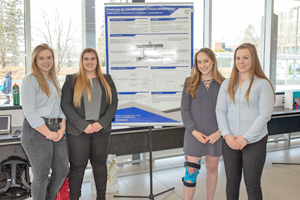
My role on a day-to-day basis can change quite drastically depending on the time of year. Currently, after passing my qualifying exam, I am in the process of setting up some new experiments. This involves designing an experimental procedure, building the appropriate apparatus to test on, and collecting data to later analyse.
As a researcher I also complete more administrative tasks like daily meetings and presentations, reading new research papers and staying up to date on the literature. Since I am also in person at the hospital my day is also spent helping clinicians, doctors, and surgeons on side projects. This could involve anything from building ‘phantom’ organs (for simulations of surgeries) to fixing a part of a surgical tool.
Coordination and collaboration
Since I started school at the peak of the pandemic, I have never known the lab during the ‘pre-COVID’ times. However, in general, COVID-19 has really impacted our ability to collaborate. A lot of what I do involves coordination and collaborating to develop new solutions or approaches to challenging problems with others. This is really hard to do when you aren’t allowed within a certain distance of each other or even more so allowed in the lab at the same time.
Conversations around the lab tend to spark inspiration, so collaboration was the biggest thing affected in my workplace.
Introducing microrobotics
Microrobotics is an emerging type of robotics specifically in medicine. Microrobotics allows surgeons and doctors to complete minimally invasive surgeries (MIS) and deliver drugs to remote locations. This means they are able to reach more remote locations deep within the body, complete more complex procedures, and treat conditions that were not accessible before. MIS has greatly improved patient outcomes for during and post-surgical procedures when compared to open surgery. This means faster recovery times, faster procedures, and less operative bleeding.
There are many ethical considerations to take into account regarding microrobotics. Firstly, ensuring it is safe for the patient and end user. This involves rigorous testing of the device to meet FDA or other health standards regarding the accuracy, controllability, biocompatibility, and performance of a device.
When thinking of microrobots a large ethical concern is automation. So other than the robot itself the algorithm designed to control it would also need to be rigorously tested.
Most rewarding parts of the role
The most rewarding parts of my role are getting to see the direct impact of my research and getting to speak with end users like patients or surgeons and seeing how they benefit from my work. For example, I recently made a stomach phantom for a gastroenterologist (GI) from the radiology department.
The accurate stomach model was made to scale of material that mimicked a stomach. The model was used to demonstrate to parents and patients (sometimes young children) how a feeding tube insertion procedure would go so they wouldn’t be concerned. It is rewarding to know that a model could bring some ease and understanding to a patient and family regarding a lifestyle-changing procedure.
Diversity touches everyone and everything

Advice for girls and women who are interested in getting into robotics: Find your personal passions
My advice for girls and women who are interested in careers in this space is to investigate your personal passions and what you find interesting about robotics and see who is a leader in that area. You can reach out to conduct informational interviews or to just learn more about what is available.
You could also look for outreach programmes in your area, that could be a robotics summer camp, district science fairs, or events run by your local university. Programmes like the WISE Campaign (championing women in science and engineering) that focus on mentorship, outreach, counselling, and inclusiveness are a great start.
Coming up next
I am looking forward to attending some in-person conferences this summer and finishing up some experiments. I am also participating in a robotics leadership programme, where I hope to develop my personal leadership skills and get more exposure for my research.

